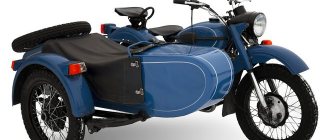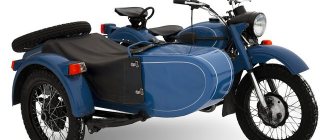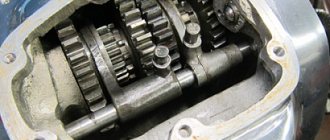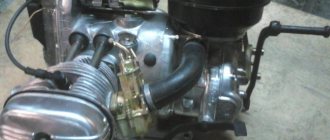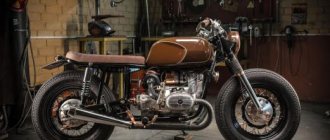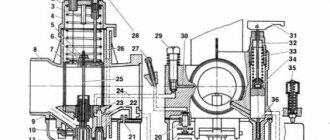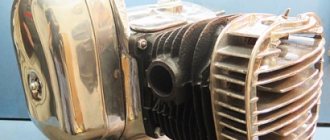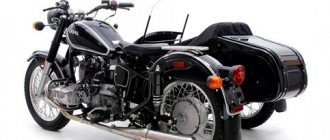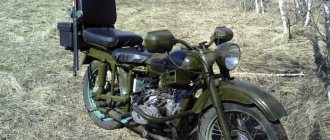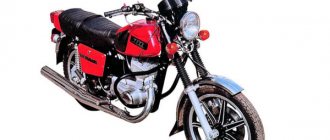(moto 12/98 page 57)
Among the owners of "Urals" and "Dneprs" they were always looking for originals that did not have enough power in the standard engine of their cars. And they set about forcing it. It was carried out in different ways: modified crankshafts, camshafts, new carburetors, and lightweight flywheels were used. In some cases it was possible to increase the power. True, often to the detriment of reliability and resource. And almost always forced engines overheated.
If you don’t want to make the same mistakes due to inexperience, get acquainted with some options for improving the quality of Uralov engines by Moscow professional mechanic Yuri Popov.
Looking ahead, I will say that experiments aimed at increasing the power of Uralov engines made it possible to achieve an indicator of about 40 hp. With. This became possible after installing larger diameter valves, a modified camshaft and pistons with a diameter of 79 mm (the normal size is 78 mm). The latter is not at all dictated by the desire to increase the engine displacement. The new diameter allows the use of piston rings instead of products from the Michurinsky plant, known on the shelves as “Piston rings”.
To reduce heat stress in the cylinder-piston group, an oil cooler was installed in the engine. They did this: two fittings were cut into the channel between the pump and the filter, so the channel was “cut”. Now the oil is cooled in the radiator before reaching the rubbing surfaces. The engine was subjected to comprehensive tests, which confirmed that the power increased to 40 hp. With.
But disappointment soon set in: the forced-up engines did not behave the best in operation. On the highway at speeds of about 100 km/h, no bad signs were observed, but in city driving mode the engine overheated. What about the oil cooler? No way! The Irbit oil pump pumps oil with insufficient pressure. So the radiator does not save you from “thermal stroke” - “stuck” occurs.
To prevent overheating of the pistons, we designed and manufactured a forced oil cooling system. There were two ways to go. The first is to intensify heat removal from the cylinder walls by replacing air cooling with liquid cooling. The second is to try to cool the piston itself. We chose the second one.
Here's how the plan was realized. A nozzle was installed in the engine crankcase, oriented so that a jet of oil escaping from it under pressure hits the inside of the piston bottom. Since the piston surface temperature is significantly higher than the oil temperature, the amount of heat removed is significant. This is what we need! We will not claim the uniqueness of our solution - to reduce the thermal stress of pistons in modern diesel engines of passenger cars, along with liquid cooling, the above method has long been used.
So, on the engine of the experimental Ural, instead of the standard one-section oil pump, a two-section one was installed, which consists of two modified standard sections with a common drive. Each section carries out its own work: in the upper (standard) section, oil is pumped into the filter and flows through channels to the rubbing parts. At the bottom - it rises from the sump, is supplied to the oil cooler and then through special nozzles is sprayed onto the piston bottoms from the crankcase side. Having taken away the heat from the pistons, the oil flows into the sump, and the process is repeated cyclically.
This design uses a standard silumin engine sump and homemade interchangeable pistons with a diameter of 79 mm with special recesses for injectors.
After installing the system, the engine was subjected to bench tests to understand what size the oil cooler should be. Luckily, the external dimensions of 200x100 mm turned out to be sufficient to ensure normal engine temperature in all operating modes. However, a radiator of this size is unreasonably large for a 650 cc engine. see. Unfortunately, this is the “merit” of the ineffective oil pump - it alone prevents the radiator from being reduced in size.
What owner of a domestic motorcycle has not thought about tuning the engine of a Ural motorcycle? This burning question worries many fans of domestic Ural motorcycles! The fact is that the standard Ural engine has many manufacturing inaccuracies and is technically imperfect. Depending on the model and year of manufacture, the power of the Ural motorcycle varies from 32 to 36 horsepower, which in our time is considered low for an engine capacity of 650 cubic centimeters. In this article we will look at how to increase the power of a stock outdated engine. I would like to note right away that a lot of turning work will be required; find a workshop in advance that will agree to help you in this matter.
The Ural boxer engine has great potential for tuning, thanks to a piston diameter of 78mm and a stroke of 68mm. With this configuration, the engine could be revving, unfortunately the quality of the parts and the purpose of the motorcycle do not allow this to happen. In the article we will look at the solution to this problem, due to which you can achieve impressive results from the operation of such an engine, namely:
- Engine head tuning
- Camshaft tuning
- Cylinders and pistons
- Carburetors and ignition
- Additional engine modifications
Additional engine modifications
In addition to the above methods of tuning a Ural motorcycle, there are several more secrets.
It is possible to install a crankshaft from the K 750 on the Ural engine, which will increase the cylinder stroke to 78mm. Thus, it is possible to significantly increase the working volume of the Ural engine. It's quite difficult to find, but it's worth it. Another problem with the motorcycle is the tight response to the throttle and slow acceleration. The reason for this is that the flywheel is too heavy, the weight of which is designed for riding with a stroller and for transporting heavy objects.
According to the drawing, it is possible to reduce its weight by a couple of kilograms. Due to the weight reduction, the inertia of the crankshaft will decrease, and the acceleration dynamics will significantly increase. To fully realize the power on the road, the gears of the gearbox must be replaced with 9 or 10 pairs. In conclusion, we would like to note that tuning the Ural motorcycle engine is justified only for racing purposes; for everyday use, such an engine will have a short resource and significant fuel consumption.
“Ural” is one of the most recognizable Soviet motorcycles. The model is a copy of the BMW R71. During Soviet times, the Ural was used by the Ministry of Defense for patrol purposes. Combat models equipped with a machine gun or launcher carrier were also produced.
The motorcycle has a 750 cm3 engine with a power of 40 horsepower. The weight of the Ural exceeds 200 kg, but despite this it quickly picks up speed. The brakes are hydraulically actuated and located on the spoke of the rear wheel. The shape of the fuel tank, lights and turn signals are designed in a militaristic style, which especially pleases fans of this motorcycle.
Modern versions of the bike are designed for riding in urban conditions and combine power and reliability. The seats are trimmed with genuine leather, which gives the motorcycle a special chic. Manufacturers strive to maintain a retro style when creating modern models.
"Ural" is valued for its retro style and modern filling. The history of the motorcycle goes back more than 60 years, and all this time motorcyclists have been trying to improve the appearance and technical performance of the motorcycle. The price for this “iron horse” is quite high, but there are fans who are ready to buy this model.
An improved Ural is almost impossible to buy. Fans who have invested a lot of time and effort into their motorcycle are not inclined to sell it. So if you want to get an improved Ural, you will have to do the tuning yourself.
Camshaft tuning
This modification requires a very thoughtful approach; as a rule, a new cam shape is created experimentally and may not meet your expectations. A wide-phase camshaft will help to fully realize the capabilities of tuned cylinder heads. For moderate tuning, you can simply install it from the Ural model M 67-36. The photo below shows a wide-phase shaft on the left, and a regular one on the right.
If you want to achieve the maximum from the engine, then it is possible to increase the profile of the cams of the standard shaft. This can be done by welding the metal using argon welding. By increasing the width and height of the cams by a couple of millimeters, it is possible to achieve a shift in torque to the high speed region and increase power also by increasing the speed of the valve timing. Take into account the fact that such an engine will lose traction at low speeds and may even stall at idle. For this modification, we recommend finding a workshop or factory that can properly process the cam profile followed by carburizing. Then, it is important to make sure that the geometry of the shaft is even; there is a high probability that the shaft could be driven by a sharp temperature change; the curvature is checked with a dial indicator by an experienced turner.
Exterior
According to the performance characteristics of the Ural-4320, it is equipped with a metal platform body and a tailgate. The car is equipped with benches, an awning and removable arches. There are also additional lattice sides. The standard equipment includes a three-seat cabin, assembled from thick-walled sheet metal, manufactured by stamping. Thoughtful glazing and rear-view mirrors make it possible to fully monitor the situation on the road and increase visibility.
Structurally, the body is made in the form of short overhangs, which improves cross-country ability. The curb weight of the truck is 8.2 tons. The weight of the transported cargo is up to 67.8 tons with the ability to tow 11 tons.
Do-it-yourself Ural motorcycle tuning
If you own a Ural motorcycle, but its appearance does not suit you, and you constantly look at foreign handsome men, do not despair. You can improve your vehicle. Most often, they buy a domestic motorcycle just for the shell, and everything else is redone.
Before you get started, check out all the proposed upgrades and photos of motorcycles on the Internet.
Having decided, you can begin work. First we redo the rear part of the frame.
- The pendulum needs to be expanded.
- Cut off the seat tubes.
- We weld curved pipes with a diameter of 28 mm, no less. This is not only a beautiful decor, it is also a headscarf amplifier.
- To make the suspension softer, the rear shock absorbers need to be installed at an angle.
- When you put the wide rear wheel in place, make sure that the rubber coupling works without distortion.
- The footrests need to be moved forward, it will be more comfortable for your legs.
- The frame needs to be lengthened by ten centimeters.
- The engine moves backwards.
Perhaps in this case the landing will be incorrect. But for every motorist it is different, individual.
After completing all the work, select a workpiece, perhaps from a stroller, for the rear wing. If you want it to be deeper, you can cut plates from it and butt weld it to the wing.
Let's start working on the tank:
- Use a grinder to remove the glove compartment.
- You also remove the neck and tunnel.
- A wedge is used to cut the top of the tank.
- The two halves are welded at the back. And the neck and tunnel are welded.
- To keep everything sealed, use epoxy resin.
Now we work with the seat:
- You need to cut the base from two-millimeter steel.
- Place thin foam rubber under it.
- The finished structure can be covered with either suede or leather.
The steering wheel needs to be made simple. Everything is cut from a single piece of metal. This is the handle, clutch lever, brakes. For the mirror stand, cut blanks from eight-mm steel. You can buy a housing for a mirror in a store or make it yourself in the form of a sphere.
Silencers are located on the right side.
- Weld the left exhaust pipe without bending it.
- The right pipe remains standard, but it needs to be shortened a little at the top so that the leg does not melt.
- The seams are cleaned, polished and chrome plated.
- To get a chopper sound, you can insert valve springs from a car into the mufflers.
External tuning
The original design of the Ural is already impressive, especially if you like the classics. But there is no limit to perfection. Owners of this motorcycle tend to customize the motorcycle according to their personal tastes. Of course, all work to improve the motorcycle can be ordered at the salon, but a real biker will always prefer to do the tuning of the Ural motorcycle with his own hands. The tuning process may be lengthy and require effort, but the result will certainly be worth it.
The following changes are most often made in the appearance of the “Ural” iron horse:
- Handles, mirrors and fairings are changed.
- The seat is made single.
- Get rid of massive “wings”.
- The steering wheel is raised and straightened slightly.
- The footrests are moved forward to make riding more comfortable.
- The original fuel tank is replaced with a streamlined tank. Tanks from motorcycles “IZH-49”, “Planet”, “Jupiter” and “IZH-56” are suitable for the “Ural”. If you have an old Ural model, then you can install a Java-250 tank on it.
- If the owner wants to turn his Ural into a chopper, then the rear wheel should be replaced with a wider one. The optimal size is 130-150. The wider rear wheel requires replacement of the rear frame.
- Parts are chrome plated.
- The clutch and brake levers are replaced with ones cut from a piece of solid metal.
- The muffler is located on the right side.
Of course, each motorcycle owner decides for himself how far he will go to change the appearance of his “iron horse”. The cost of this model is quite high, so if you need a completely modified bike, it is better to buy something more affordable. But if you like the classic Ural motorcycle, this is your choice. Photos of tuning these bikes can be found on the Internet and you can choose the option that you will focus on.
Ignition
Following an increase in power and replacement of pistons, it is advisable to replace the spark plugs. Spark plugs A20 DV and A17 DV from Zhiguli are suitable for Ural. Some craftsmen install an additional candle. This increases engine power at high speeds, reduces consumption and can become a replacement for boost. But work will have to be done to develop an independent spark generation system. At the same time, the air filter is changed, which reduces friction losses during intake.
If the engine is old, then it is advisable to replace the carburetor and install an injector. This can be done with your own hands or with some help. Tuning the Ural motorcycle can be done using injection spare parts from the VAZ "Ten"
At the same time a new starter is installed. Starters from the Vikhr outboard motors ST 353, ST 367, ST 369 are suitable for IM3. VAZ motors - from models 9, 10 and 11 - are also successfully built in place of the originals.
On the subject: How to delete music from an iPhone via iTunes: instructions and recommendations
Specifications
Let's do a full analysis of technical data based on one of the first models - Ural M-62.
Ural M-62
The heavy Soviet motorcycle was equipped with a four-stroke carburetor two-cylinder engine with opposed cylinders and air cooling:
- working volume – 649 cubic meters. cm;
- cylinder diameter – 78 mm;
- piston stroke – 78 mm;
- compression ratio – 6.2;
- maximum power – 28 hp. s., 20.6 kW;
- crankshaft rotation speed at maximum power – 5,000-5,200 rpm;
- maximum torque – 47 Nm;
- carburetor - K-38;
- air cleaner – combined inertial contact-oil filter with two-stage cleaning.
Transmission:
- clutch: dry double-disc, driven discs with linings on both sides;
- cardan transmission: cardan shaft with an elastic coupling and a hinge on needle bearings;
- main gear: a pair of bevel wheels with spiral teeth, gear ratio - 4.62;
- gearbox: four-speed, with gear ratios in 1st, 2nd, 3rd, 4th gears 3.6, 2.28, 1.7, 1.3, respectively.
Electrical equipment:
- ignition system - battery;
- voltage – 6 V;
- battery – ZMT-12;
- generator – G-414;
- relay-regulator – PP-31;
- breaker-distributor – PM05;
- ignition coil - B201.
Chassis:
- frame – tubular double closed type;
- Front wheel suspension – telescopic fork with double-acting hydraulic shock absorbers;
- rear wheel suspension – spring;
- front wheel travel – 80 mm;
- rear wheel travel – 60 mm;
- tire size - 3.75-19 inches;
- brakes are shoe brakes, with friction linings on the front and rear wheels.
Refueling volumes:
- fuel tank – 22 l;
- engine crankcase – 2 l;
- gearbox housing – 0.8 l;
- final drive housing – 0.15 l;
- air purifier – 0.2 l.
Dimensions:
- length – 2,420 mm;
- width – 1,650 mm;
- height – 1,100 mm;
- motorcycle base – 1,100 mm;
- ground clearance at full load and normal tire pressure – 125 mm;
- track – 1,130 mm;
- maximum speed – 95 km/h;
- weight – 340 kg;
- maximum load – 255 kg;
- average operating fuel consumption per 100 km when driving in various road conditions with variable load is 6 liters.
Liter for the Urals. Engine repair turned into a mess
They say about the “Ural” boxer: little power and a lot of noise. What bothered me most of all was the noise... There was a case that did not happen to me... Foreign guys arrived to go on a motorcycle rally across Russia, all of them driving foreign cars. They warm up the motorcycles and wait for the accompanying Ural to start. Finally it started working - and drowned out all the “bourgeois” motorcycles with its noise.
It wasn’t the rumble of an exhaust – it was the engine that made a roar and clang. That’s why the guests were amazed: they say they’ve seen and heard a lot of things in the world, but to do this! The culprits of this disgrace are the camshaft and generator drive gears. The reason is not so much the poor manufacturing quality of the gears themselves (which is quite acceptable), but rather the fact that there are gaps between them. First, the camshaft cam compresses the valve spring through pushers, rods and rocker arms - while one side of the teeth is loaded. And when the top of the cam is passed, the force of the compressed spring tries to turn the camshaft further, while loading the other side of the teeth. At the moment of transition through the top of the cam, the load is transferred from one side of the tooth to the other. This is the ringing we hear.
This is what is located under the chain drive: 1 – oil is supplied to the front camshaft journal through a plastic tube; 2 – plate that holds the crankshaft from axial movements.
In the engine, instead of three ever-howling gears that drive the camshaft and generator, sprockets are installed. The drive became chain. There will be no more howling.
You can’t get rid of the gaps: the aluminum alloy from which the crankcase is cast, heating up during engine operation, expands quite strongly, the distances between the axes of the crankshaft, camshaft and generator increase - and so the gaps expand. If you try to reduce them, then on a cold engine the gears will push their teeth against each other - then it’s not far from failure. The only thing that can be done is to try to reduce the noise by adjusting the position of the generator. But don't expect any special results.
Should the camshaft be driven by a belt, like the VAZ-2108 engines? This is generally a silent option, but the amount of alterations frightened me, and I abandoned it immediately. And where can I get a belt of suitable length? And if you use a chain drive (by the way, BMW designers also followed this path on their boxer cars)? After all, the chain is easy to rivet to the desired size.
I used timing parts and a chain from Moskvich. Immediately, the question is: where can I get a sprocket to drive the generator? I found the one I needed on the chain tensioner of the same Moskvich. Adapter bushings are welded to all sprockets so that they “sit” on the “Irbit” shafts. Since the distances between the shafts are small, the “branches” of the chain turned out to be short, which means that tensioners and dampers are not needed for it.
This alteration entailed quite serious changes to all engine components - after all, the camshaft now rotated in the opposite direction, and not only the operation of the valve mechanism depends on it. The gear at its rear rotates the oil pump, and at the front end of the camshaft there is an ignition system rotor and a breather valve drive. Most of the fuss is with altering the camshaft itself. The part was cut in the middle on a lathe, and a steel bushing was inserted into the cut. One pair of cams was rotated relative to the other by 120°, and the joint was welded using argon welding. After heating, the part, of course, “led”, but I did not dare to straighten the hardened, and therefore fragile, part with a hammer - the risk of breaking it was too great. He acted cunningly: in the area of the joint he made a small point with electric welding - and the part immediately bent a little. And so on until the shaft runout practically disappeared. On the first version of the motor, the cam height was increased by 4 mm. The new engine has a standard camshaft. As experience has shown, large valves and rocker arms with a modified ratio of the arms of the heads from the “Wolf” (and they are installed on the engine) provide quite sufficient flow sections. In addition, enlarged cams can only work with “Dnepr” pushers. The same engine retains the “Irbit” ones. In order to use the “Stary Oskol” ignition system with a changed direction of rotation of the rotor sitting on the camshaft, the sender wires were swapped. I only had to adjust the ignition timing. To do this, I made a new cut on the rotor for the pin, and during the finishing process, I also moved the holes for the bolts for fastening the sensor plate.
The breather spool drive also underwent minimal modifications: a new cut was made in the glass itself for the camshaft gear pin.
The most important part of the work is upgrading the lubrication system. Sliding bearings are used as main bearings in this engine (instead of the “original” ball bearings), and simply splashing the oil on which the entire Ural lubrication system is built is not enough for them - they require stable oil pressure. The “Dnieper” oil pump has much higher performance - that’s what I installed. But after altering the camshaft drive, the pump gears began to rotate in the other direction, that is, the input and output practically swapped places. As a result, I removed the standard oil pump bypass valve and moved the oil intake in its place. Oil enters the engine through a tube from a hole on the other side of the pump.
The channels leading to the oil filter were plugged. Now the oil flows through a cut-in fitting through a hose into the radiator (made from a third of the GAZ-51 oil radiator), then flows through the fitting to the bypass valve located in the oil filter cover, and after the filter into the engine oil channels. I stuck a pressure gauge into the break in the hose in front of the radiator. Tests have shown that after all the modifications, the idle pressure does not drop below 1.5 kg/cm2.
A considerable amount of noise is created by ball bearings - there are plenty of them in the Ural engine. This means that you need to get rid of them in favor of plain bearings.
It’s quite difficult to “part with” connecting rods: there is no room for oil channels in the standard crankshaft. Therefore, for now I decided to limit myself to altering the original ones. In the first version, the space occupied by the bearing in the crankcase was filled with bronze-graphite, in which the crankshaft journals rotated. This option turned out to be quite workable, but I still decided to use traditional parts - connecting rod bearings from Volga. I pressed hardened steel bushings onto the main journals and ground them to “Volgov” size. I pressed bushings with the internal dimensions for installing the liners into the hole for the bearing, and made grooves for their antennae. The inserts are inserted into them from the side. The crankshaft is kept from axial movements by a plate attached to the front journal.
For greater wear resistance, bronze-graphite is deposited on the plane on which the crankshaft rubs against this plate when the clutch is pressed. On the other, less loaded side, the crankshaft is held by a sprocket. The ball bearing on the front journal of the camshaft also gave way to a bushing - it is made of duralumin. To lubricate the liners, I drilled oil channels, and the lubricant had to be supplied to the camshaft bushing through a separate plastic tube - there was no other way.
In the first version of the engine, the displacement after installing pistons from the 2-liter Moskvich D 88 mm increased to 828 cm3. What if we increase it further? And I installed the crankshaft from the Wolf. With its 78 mm crank radius, a volume of 948 cm3 was generated. This additional 10 mm of piston stroke led to a chain of alterations.
When installing “Moskvich” pistons, which are 10 mm larger than the standard ones, you won’t be able to get by with just one cylinder bore. I cut out sleeves from the “wolf” cylinders (they cannot be pressed out - they are “filled”).
I made new sleeves with an outer diameter of 95 mm from Moskvich ones and pressed them with an interference fit of 0.05 mm. After installing the crankshaft with a “long” stroke, spacers had to be slipped under the cylinders. Their thickness together with the gaskets was about 9.5 mm. In order for the “Dnieper” rods to reach the removed rocker arms, I welded a 15-mm piece of “Ural” rods to each of them. Under the guide covers I inserted rubber bushings from Zhiguli silent blocks. As it turned out, they have excellent resistance to oil.
Disorder: the engine displacement has increased, but the volume of the combustion chamber in the head has remained the same. Moreover, part of this volume was “eaten” by the convex heads of the “Moskvich” pistons. To ensure that the compression ratio remained within reasonable limits, I arranged it so that the pistons did not reach the top edge of the cylinder by 8 mm. But even now the engine detonates from time to time, even on 95 gasoline. We'll have to make the spacers under the cylinders even thicker.
I used an Okovsky carburetor, but it had to enlarge the holes of both accelerator pump nozzles to 0.8 mm. And to the place where the jets of gasoline coming out of them fall, he brought steel tubes. The second ends of the tubes were brought to the junction of the manifold with the cylinders.
Only after that the motorcycle really started moving. After installing the “wolf” crankshaft, the carburetor turned its primary chamber towards the manifold pipes. Either this turn had an effect, or everything happened due to the increased working volume, but the engine “sucks” everything it has prepared from the carburetor, down to the last drop, and now additional pipes, it turns out, are not needed.
I forgot about failures in engine operation like a nightmare. But the question is tormenting: shouldn’t the Okovsky carburetor be replaced with another one - larger - after all, the engine has long outgrown the Oka engine in volume. Or try fuel injection?..
But I just wanted to repair the old Ural.
The starter from the “ten” is small, but it is still a hindrance. To get around it, the shape of the intake manifold pipe had to be complicated. Between the cylinders and the crankcase there are spacers and two paranitic gaskets with a total thickness of 9.5 mm.
Specification of the modernized engine for the Ural motorcycle:
Engine type: 2-cylinder, opposed, 4-stroke Displacement, cm3: 948 Dimension, mm: 88×78 Power, hp: sufficient (for now) Compression ratio: 9.5 Main bearings: GAZ-24 connecting rod bearings Timing drive : chain Lubrication system: completely redone: pump from Dnepr, radiator - 1/3 from GAZ-53, mechanical pressure gauge, filter from Ural with bypass valve Power system: DAAZ-1111 carburetor, modified Starting system: electric starter from VAZ -2110
Author: Oleg Weber, Shchelkovo, Moscow region, source: MOTO magazine
759
Weaknesses of the IMZ-8.103-10 (IMZ-8.103-30, M-67-36) engine of the Ural motorcycle
- Foot starter (kickstarter);
- Gas and clutch cables;
- Generator;
- Carburetors;
- Cylinder heads;
- Reverse gear (gearbox).
More details about the weak points of the motor...
The foot starter of the IMZ-8.103-10 engine is a weak point due to the slippage of the pawl. The malfunction is eliminated after dismantling the gearbox and disassembling it with rearranging the pawl with the other side or replacing it. I have an assumption that the metal of the dog is of low hardness. On the other hand, if the pawl is made harder, the gear will fail. You need to choose the golden mean.
The clutch control and fuel supply cables are a weak point due to their short service life. To put it simply, they tear, and before that they stretch, which makes it necessary to adjust the timing of the supply of the fuel mixture, as well as the clutch.
The generator does not run for a long time.
Gasoline gets into the floats, after which the cylinder is filled with gasoline. In addition, carburetors are not matched to these engines; half of the fuel goes to waste, which is not economical. It would be nice if the engine had one carburetor instead of two.
Do not overtighten the spark plug heads; the threads break off quite easily. You cannot overheat the engine, the result will be clearly visible on the heads, the studs are pulled out, leading to the landing plane of the heads. If you are unable to avoid breaking the spark plug thread, contact a familiar turner; he will be happy to repair it and install a steel threaded bushing for a modest fee. I can recommend the same for wear of valve seats and chamfers. It is much cheaper to repair heads than to buy new ones; a good turner can do this in no time.
The reverse gear does not work for a long time due to the rapid wear of the reverse gear in the gearbox.
INCREASING URAL ENGINE POWER
Many motorcyclists dream of increasing the engine power of their Urals.
But not everyone understands what should be done for this and what consequences boosting the power unit can lead to. Firstly, work related to changing its design can only be carried out by a very qualified mechanic and with the availability of machine tools. Attempts to do something in a hurry are doomed to failure. Secondly, the engine, boosted according to sports-cross models, has a torque characteristic of little use for economic purposes, shifted to the high-speed zone and unimportant fuel efficiency. So before you start changing anything in the factory design, think carefully about whether you can handle a very serious job and whether you need it. This material is a generalization of the experience of reconstructing the engines of serial road motorcycles M-63, M-66, M67-36, as well as serial sports engines M-63K (motocross) in preparation for competitions and runs by athletes of the DOSAAF society.
ATTENTION! Boosting an engine may be advisable only if it is practically new or has undergone a thorough overhaul. If your power unit does not meet the specified requirements, then there is a risk of losing what you have.
To increase engine power, the compression ratio should be increased from 7-7.2 to 8.5. With this value, you can only use gasoline AI-93, A-95, A-98, “Extra” and the like with an octane number of at least 85-95.
It is impossible to increase the compression ratio to such limits using standard pistons from Ural. Therefore, taking into account the data in Table 1, you should select pistons from the MT-8 engine (K-650 Dnepr) with a spherical head. In this case, to prevent the piston from colliding with the cylinder head, it is necessary to chamfer the step formed by the transition of the spherical combustion chamber to the mating plane of the cylinder head, ensuring a gap of at least 1-1.5 mm. To prevent the piston skirt from touching the crank pins, a special cut is milled on it, and the valve seats are changed on the piston bottom, since the camber angles of the latter are different for the MT-8 and M-63 engines (Fig. 1). To check whether the valves are touching the bottom of the piston, strips of plasticine 3-4 mm thick are applied to it, then the cylinder head is completely assembled and the crankshaft is turned. The presence and size of the gap between the valves and the piston are judged by the imprints on the plasticine. It should be at least 2-3mm. Before installation on the engine, the pistons are weighed, and the difference in weight should not exceed 2 g.
When boosting an engine from an M-63K sports motorcycle with cylinder heads trimmed at the factory, metal gaskets 2 mm thick are placed under the cylinders. Between the cylinder and the metal gasket, as well as between the latter and the crankcase, paper gaskets are placed for sealing. When using road bike parts, the spacer under the cylinder can be about half as thin. In any case, its thickness is finally controlled by on-site measurements.
The boost stage ends by clarifying the compression ratio in each cylinder. For this purpose, the piston is brought to TDC with the valves closed (end of the compression stroke). The engine is tilted so that the spark plug area on the cylinder head, in which the volume of the combustion chamber is measured, is located horizontally. In this position, spindle oil is poured into the cylinder from a graduated beaker. It is necessary to ensure that the volumes of the combustion chambers in both cylinders (and therefore the compression ratio) are the same. This can be achieved by changing the thickness of the gaskets described above.
To improve cylinder filling, it is necessary to reduce the aerodynamic resistance of the intake and exhaust channels. To do this, the balls carefully clean out the casting errors in them, and then polish them. The intake and exhaust valve heads are also polished.
To ensure a normal service life of the compression piston rings and improve the piston seal, at increased speeds of a forced engine, standard compression rings with a machined internal one-sided chamfer should be used (Fig. 2, a). This makes it possible not to reduce the mass of the rings and to reduce the impact on the cylinder walls. Even better results are obtained by using L-shaped torsion-type rings (Fig. 2, b). To make them, a serial ring is fixed in the chuck of a lathe using a mandrel (Fig. 2, d) and then a recess is made.
Since it is not always possible to make a new piston with grooves for two L-shaped rings, you can cut one groove for it above the upper groove, right at the edge of the piston bottom. A rectangular ring with a machined chamfer is placed under the L-shaped ring. The lower groove remains empty (Fig. 2, e).
When boosting the crankshaft speed, textolite washers are installed under the valve springs to lighten the pushers. Push rods are made of titanium or duralumin tubes with steel tips (Fig. 3).
On each cylinder, using a calibration disk mounted on the crankshaft axis, the valve timing is checked according to the data in Table 2. It is better to register the beginning of valve opening using an indicator. Adjustment of the valve timing can be done on the removed cam shaft by sanding the cams by hand with fine-grained abrasive stones or using a rubber grinding wheel and an electric drill. In this case, it is important to remove the minimum necessary amount of metal in order to preserve the upper cemented layer and distort the overall shape of the cams as little as possible. Their surface should be polished to a mirror shine.
It wouldn’t hurt to replace the standard ignition system with a contactless electronic one installed on the Ural-Solo.
Candles can be recommended A 20 DV, A 17 DV from the Zhiguli car, however, due to the large length of the thread, brass washers 8 mm high should be placed under them.
A contact-oil air cleaner is completely unsuitable for a forced engine. The best solution is a homemade filter with a paper element from Zhiguli. As a last resort, you can use an air filter with a paper element from the Dnepr motorcycle.
The M-63 engine, boosted using the described technology, must develop a power of at least 30 kW (40 hp).
According to VNIIMotoprom, with a compression ratio of 8.5:1 and 5900 rpm, the engine power can be up to 33.6 kW (45 hp).
Ural's position now
Before the notorious events of the early nineties, about three million devices were produced. After the collapse of the Union, the plant's position began to deteriorate. The purchasing power of the population fell sharply, factories in the country were closed and sold off. Fortunately, the unenviable fate passed the Ural. Production continued. These were mainly motorcycles with a sidecar (with or without a drive), with a 4-stroke opposed two-cylinder engine with a volume of 745 “cubes” and a power of 40 “horses”, plus 4 gears and reverse gear.
Since the mid-90s, almost all parts in the design of the Ural motorcycle have been improved or replaced with new ones. In honor of the 70th anniversary of the plant in Irbit, modernized models were produced, one of the best is the Ural motorcycle with M70 Sidecar tuning.
The sale of models already produced in Russia, and not in the USSR, is aimed at foreign countries. 97% of all models of the plant are sold in the USA, Europe, Canada, and Australia. Asia is considered as one of the promising markets: Japan and Korea. In these countries there are simply no competitors in the niche of motorcycles with sidecars, but there is demand. China, as a sales market, has been producing a replica of the M-72 under the guise of a copy of BMW since the 50s.
Painless changes
You should not assume that any painless tuning for a Ural motorcycle will be easy to do. But, as they say, hunting is worse than bondage. For clarity, we will divide possible alterations into external and internal. The external ones are aimed at correcting the veteran’s appearance, while the internal ones will affect his driving performance and technical characteristics.
Appearance correction
Classic shapes, characteristic of all models without changing, go well with an abundance of chrome parts. Since chromium has good anti-corrosion resistance, it is not forbidden to use it even in the most unexpected places. After this processing, many details will look good:
- Front and rear wings.
- Fuel tank.
- Side panels.
- Engine crankcase, cylinders and cylinder heads.
- Frame and suspension elements.
But if there is no opportunity or desire to do chrome plating, high-quality painting of a Ural motorcycle can be an alternative. There will be room to turn around, especially if you have a modification with a stroller.
Good results can be achieved by installing wings of a different style and size, a different fuel tank, roll bars and even optics. Many favorite modifications - installing a high steering wheel and new control handles, altering the seat, without the right approach, worsen the rider's position, making it less comfortable
Such changes should be made with caution
Inner harmony
Many owners start tuning the Urals to improve the technical characteristics of the motorcycle. Despite some orthodoxy in the design of the engine and gearbox, there is room for improvement here. The following steps can be taken:
- Installation of crankshaft (crank) support bearings, the quality of which is better than standard ones. It is not recommended to reduce the size of the support necks themselves. After all, this removes the heat-treated layer and reduces the strength of the critical elements.
- Reduced weight of pistons and connecting rods. Excess mass of these parts leads to an increase in the moment of inertia and a decrease in engine power. Even simply by removing the casting flash, you can significantly reduce the weight and increase the effective output of the power unit.
- Alignment and grinding of inlet and outlet channels. Grinding in valves. Such procedures will improve the filling of the cylinders with the combustible mixture.
- Manufacturing a new camshaft with a different cam profile, allowing the valve timing to be changed. This is a complex engine tuning that requires special knowledge.
- Installation of new carburetors. A well-proven measure that allows you to get rid of failure during acceleration, which is characteristic of all IMZ models without exception.
This is due to the fact that the manufacturer equips the equipment with variable-discharge carburetors, which are poorly suited for four-stroke motorcycle engines. You can get rid of this by equipping the motorcycle with suitable constant-vacuum carburetors. Both Mikuni and Keihin have such models. To optimize operation, the flow area of the nozzles will need to be adjusted. Ideally, such modifications are carried out on a special stand. In the absence of one, one has to be content with fitting in road conditions. After such engine modernization, the Ural will accelerate much more confidently. - Replacing standard air filters with others that have similar throughput but less resistance.
- Installation of inertial boost. This will only work if you purchase components from a reputable manufacturer. There are often low-quality or even non-functional components on the market.
- Manufacturing of new gearbox gears. Despite the relative labor intensity, this motorcycle tuning is more than justified. Original gears are often not of high quality and not only make it difficult to change gears, but also make noise during operation.
- Installation of alloy wheels. Such modernization is not always justified. A cast wheel, if it is not spoked, will look ridiculous on a classic.
Whether you make all the upgrades, or just some, in any case, tuning the Ural motorcycle engine will be completely justified.
Engine head tuning
Through the channels of the engine heads, the cylinders are filled with a fuel mixture, and exhaust gases are released. The more efficiently the cylinders are filled and the exhaust gases escape more easily, the greater the engine power. To tune the Ural engine heads, you will need to remove the valves. The diameter of the original Ural valves is only 38mm inlet and 35mm exhaust, which affects the suffocation of the engine. Along with the valves, you need to press out the old valve seats and guides. The seats for the saddles should be bored to the size of the Dnieper saddles. New enlarged seats will allow the installation of larger diameter valves 40mm inlet and 38mm exhaust from the Dnieper. The best alternative to Dnepr valves would be valves from Audi. The quality of automobile spare parts is much higher, and thanks to the fixation with new type of crackers, the service life of the heads can be significantly increased. We recommend using bronze valve guides from VAZ 2101-2107.
Internal grooves improve lubrication of the valve stem. The movement of valves in them is the most efficient with minimal friction losses, and the service life is much longer. Bronze perfectly removes heat from the valve, which will have a positive effect on the stability of valve clearances.
It is important to know: when choosing valves, do not run into a fake. Exhaust valves made of heat-resistant steel should not be magnetized. Bronze guides are also not magnetic.
Please note that the gap between the guide and the valve stem is required from 0.04 to 0.06 mm. The valve should move freely in the bushing without dangling in it. By the way, we would like to note that the car guides have a seat for the oil seal. We strongly do not recommend installing it, since lubrication occurs by splashing oil, and not under pressure as in cars. After installing new valve guides, pay attention to the trimming of the valve seats. It is necessary to trim the seat along three chamfers: 60, 30 and 45 degrees, of which 45 degrees is the working one, which comes into contact with the valve plate, ensuring a tight fit. You will also have to replace the standard valve springs with automotive ones from the VAZ 2108. They are somewhat stiffer than the original ones, and are able to ensure smooth operation of the valves at high speeds. But keep in mind that with such springs, the camshaft is subject to accelerated wear - tuning a motorcycle engine requires sacrifice. The final procedure for tuning the heads is to bore the intake and exhaust channels with a cutter a couple of millimeters larger in diameter. At the same time, it will be possible to get rid of casting sagging and ensure better engine breathing. The exhaust channel should be polished to a mirror, and the intake channel should be left matte, slightly rough, to prevent fuel condensation on the walls. After tuning the heads, do not forget to blow out all the channels and hard-to-reach places with compressed air, and grind in the new valves. Grinding must be done manually using a two-component lapping paste. Never use a drill. A hose is put into tension on the opposite end of the valve stem, thus rotating the valve with your palms until you get a matte ring on the seat and valve plate with a thickness of 1.2-1.6 mm. Check the tightness of the valve by pouring keratin into the channels for 1-2 minutes.
Description
The Ural motorcycle engine is a two-cylinder, four-stroke, air-cooled power unit. It is equipped with an electronic fuel injection system (injector) developed by the engineering company ElectroJet Inc.
The main power element of the motor housing is the crankcase. Structurally, it consists of:
- the crankcase itself;
- distribution box covers;
- front and rear bearing housings;
- pallet;
- front cover.
The crankcase is cast from high-strength aluminum alloy. Pistons and the junction box cover are also made from it. The cylinders that are installed in the crankcase are cast from special cast iron, which has increased strength. Their internal surfaces are honed before installation, bringing the surface cleanliness to almost a “mirror state”. The materials from which the pistons and cylinders are made during operation form a good anti-friction pair that is not subject to severe wear.
In addition to the parts of the cylinder-piston group, a crank mechanism, a gas distribution mechanism, etc. are installed inside the crankcase and on its outer walls. In this case:
- the camshaft is installed in the upper part of the crankcase on bearing supports, and the pushers are located on its two sides;
- the junction box cover is attached to the front wall;
- the oil filler neck with a plug equipped with a dipstick is located on the left wall;
- the crankshaft is mounted on main bearings installed in the walls;
- From below, the crankcase is closed with a special steel pan, which is used as a reservoir with engine oil.
The assembled engine is installed on the motorcycle frame and secured to it with two studs.
Tuning
The opposed two-cylinder engine of the Ural motorcycle has great potential for technical tuning. However, it is recommended to carry out this process only on a new or well-repaired engine.
In addition, its completion should be entrusted only to highly qualified specialists with experience in carrying out such work. This is due to the fact that the process of increasing power affects almost all engine components.
So the following needs to be modified:
- cylinder heads;
- camshaft;
- pistons and cylinders;
- fuel supply system;
- ignition system;
- crankshaft and flywheel.
Having completed the entire scope of work, you can achieve a significant increase in engine power, however, it should be noted that this significantly increases fuel consumption and reduces engine life. Therefore, such tuning is recommended only if the motorcycle is intended to participate in sports competitions. It is not advisable to use it for any other purpose.
History of the Urals
The world first learned about this new product back in the 20s of the last century, and then the first copy was produced with a powerful 1,200 cc engine and a power of only 24 hp. At low speeds the Ural handled perfectly, but after the 60 km/h mark this indicator disappeared. It is also worth noting that the designs and some parts of the motorcycle were borrowed from another foreign manufacturer, so the first Ural M-72 was not completely Russian, it had a particle of the German BMW R-71.
Then the manufacturer experienced several ups and downs; World War II forced them to reconsider production. After the war, the bikes were produced as military motorcycles with a special design: PKMB machine guns were built into them. Further in the Soviet Union, the legend was actively sold; about 3 million copies were sold. But after the collapse of the USSR, the situation worsened significantly and production decreased significantly. Today you can see photos of new Ural motorcycles; 2021 was an excellent update for them.
Today's Urals are represented by several models. They are equipped with an engine with a volume of 750 cubic meters and a power of 40 horses. With a large weight of 200 kg, the motorcycle is capable of traveling at high speed without losing control. Also, the new motorcycles received a completely standard, but stylish appearance, which is made in a militaristic style.
Bright, stylish, but still Dnepr
Looking at this motorcycle, different emotions immediately appear in me. On the one hand, the author of the project had a hand and spent a lot of time creating this “horse”, but on the other hand, I don’t see much point in them. It is unlikely that this homemade seat will be more comfortable than the standard one.
Exhaust
- the highlight of the whole design. As for me, the “cans” are too massive for the pipes that go directly to the cylinders. I think if they were made thicker in cross-section, this modification would look somewhat more impressive.
The colors here are extremely bright and dull
, but this is
a matter of taste
.
And, according to the classics of the genre, we are witnessing the abandonment of the steering wheel and the fact that the author of the project gave preference to clip-ons, completely cutting down the ability to move around on this motorcycle.
Conclusion
In the next article (or articles) I will tell you in detail about how this Ural enduro motorcycle was created. Overall, I was completely satisfied with the result; Over the course of several visits, no serious deficiencies were identified. Of course, this is not the final version yet; plans include installing “toothy” tires, final painting, installing new rims and maybe something else, as well as changing the oil, piston rings and other repairs. First of all, it is worth installing toothy tires, because... On a regular road motorcycle, the Ural rides very, very poorly in the mud, almost not at all.
Installing motocross tires is a top priority
vote
Article rating
Repair and maintenance
Hearing another knock from the engine, the owners of the Russian motorcycle understand that the evening will be spent in the company of an iron friend. So it is with the Ural, frequent malfunctions are one of the features of the bike. Here are the main engine problems and their causes:
- The engine won't start. This happens in cases where:
- fuel does not flow into the carburetor (fuel supply system is clogged);
- no spark from the spark plug (breakage, carbon deposits or other reasons);
- violation of compression (lack of clearance in the valves, leaky fit or malfunction of the rings).
Work interruptions occur for the following reasons:
- uneven supply of fuel;
- water ingress;
- blockage in the fuel mixing system;
- problems with candles;
- violation of wiring integrity;
- capacitor failure;
- excessive amount of gasoline entering the air-fuel mixture.
Engine knocking occurs due to the following reasons:
- early spark supply;
- severe overheating of the motor;
- problems with pistons and rings (grinding, chipping, poor seal, etc.).
At the first sign of a breakdown, it is worth repairing the engine. Otherwise, you can aggravate the situation and the cost of repair. To avoid malfunctions, you should follow the rules of operation and maintenance of the motorcycle
It is even important how much oil to pour into the engine of a Ural motorcycle. Excess will interfere with operation, and deficiency will contribute to wear of parts.
It is also necessary to regularly replace filters, gaskets and other consumables.
In general, IMZ produced an excellent bike suitable for people of any age category. It is designed for both work and leisure. If you want to buy a motorcycle, Ural will be an excellent option on a low budget.
Carburetors and ignition
Tuning a Ural motorcycle engine affects all engine systems, including ignition and carburetors. It is recommended to read the information: how to properly configure Ural carburetors. The standard ignition is so outdated that it is not even suitable for everyday driving, let alone anything else. It is desirable to install a microprocessor ignition with the possibility of an automatic advance angle. This article will help you set up the electronic ignition system. Ideally, such an ignition would be installed with a programmable controller with the ability to adjust the firmware. Such ignition systems have another useful feature - speed cut-off. This will prevent over-torque of a heavily boosted engine. Well, for maximum spark strength, in combination with a new ignition, you can use a coil from the Oka or Gazelle. Branded high-voltage wires with silicone insulation and internal resistance are required, for example from Tesla from VAZ 2108. They will ensure an uninterrupted spark in any weather and eliminate the possibility of spark breakdown to ground. As for carburetors, you will need to install Japanese vacuum carburetors with a diffuser diameter of 32 to 36 mm, followed by selection of jets, synchronization and adjustment with a gas analyzer. Tuning on a dynamometer is highly advisable, where you can test different settings and ignition timing and get the most out of your motorcycle tuning!
Tuning for the Ural motorcycle or its restoration
Here a lot depends on the condition and modification of the bike. If a representative of one of the latest lines arrives in your garage, which is in perfect order externally and runs, be prepared for the fact that remodeling it will turn out to be quite expensive - you will have to pay relatively a lot for components. Add to this the price of an iron horse that came off the assembly line, starting at 300,000 rubles, and think about whether the changes are worth such expenses.
It’s a different matter if you somehow become the owner of a rare specimen: restoring it is not just a matter of honor, but also quite a profitable business. By restoring a rare model, you will bring history back to life and get a status vehicle that can be sold for good money.
And the third case, if you have a very ordinary Ural with a cradle: tuning will allow you to diversify the design of an ordinary motorcycle or increase its technical characteristics and at the same time will cost a very reasonable amount.
Suspension tuning
Motorcyclists are not satisfied with the suspension, and they are thinking about what to replace the front fork with. One of my friends left his original fork, but replaced the springs with Izhevsk ones. The suspension became more comfortable, but comfort was not enough.
There is another option for upgrading the suspension, this is a fork from a Japanese motorcycle. The Japanese market is famous for its bikes. The first rather successful option, which will have to be digested a little, is the fork with the CBR 900 RR. This is a classic inverted fork that has proven itself very well.
If you decide to replace the fork, then take it with the wheel, brake discs and calipers, this will give you the opportunity to get rid of many problems in the future. But if your budget does not allow you to buy a Japanese part, then the Izhevsk fork with homemade traverses made of aluminum alloy should satisfy you.
Return to contents — ↑
